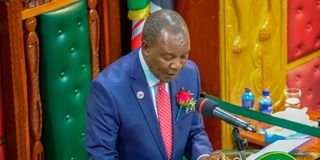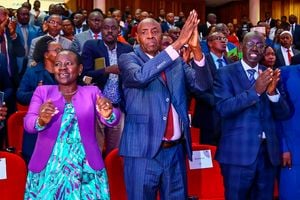
National Treasury and Economic Planning Cabinet Secretary Prof Njuguna Ndung’u reads the budget in Parliament on June 13.
The budgetary allocations for the education sector that National Treasury and Economic Planning Cabinet Secretary Njuguna Ndung’u presented in Parliament last week leave glaring gaps in funding various programmes.
The underfunding cuts across basic, university as well as technical and vocational education and training (Tvet) sub-sectors but basic education is the most affected.
This is likely to worsen the situation where many education institutions are reeling in debt.
In his statement in Parliament on Thursday last week, Prof Ndung’u announced that Sh13.4 billion had been allocated for conversion to permanent terms 46,000 junior school teachers who are employed on contract.
This came as a relief because the government had earlier indicated that only 26,000 tutors would benefit and at a cost of Sh8.3 billion.
However, the figure do not add up. Junior school teachers are employed at a job grade C2 (T-scale 7) a basic salary of Sh419,460 per year.
They also earn monthly commuter and house allowances which depend on the area a work station is situated in.
For their level, the minimum annual house allowance is Sh115,200 and Sh60,000 in commuter allowance.
Therefore, to employ one teacher on permanent terms for one year, the TSC requires at least Sh594,660. To employ all the 46,000, the TSC therefore requires Sh27.4 billion.
A statement released after the Kenya Kwanza Parliamentary Group meeting at State House on Tuesday gave yet another figure.
“The PG was also informed that adequate funds (Sh18 billion) have been provided for the employment of all 46,000 junior secondary teachers who are on internship. Funds have also been provided to hire 20,000 interns next month. The policy is now to transition teachers from internship to permanent and pensionable terms,” the statement read.
No explanation was given was given for the new figure which is more than the budgetary allocation.
The free education programmes have also been allocated less money than they require and heads of schools can only expect to work with less capitation.
When he made presentations before the National Assembly Committee on Education, the principal secretary for Basic Education, Belio Kipsang said that the Free Primary Education requirement is Sh9.781 billion.
However, the programme has been allocated Sh9.1 billion, leaving a deficit of Sh660 million. Learners in primary school get a capitation of Sh1,420 per year.
Dr Kipsang had asked for Sh76.7 billion for the Free Day Secondary Education programme.
The Budget Policy had allocated the programme Sh63.9 billion but when Prof Ndung’u read the budget speech, he had slashed this to Sh61.9 billion.
Each learner in a public secondary school is supposed to get Sh22,244 in tuition fees per year but this has fallen to about Sh17,000 due to inadequate funding, leaving schools with huge debts owed to different suppliers.
According to the Ministry of Education, the capitation requirement for junior school learners is Sh46.1 billion. However, Treasury has allocated Sh30.7 billion for the learners, leaving a gap of Sh15.4 billion.
The MoE plans to construct between 16,000 and 18,000 classrooms in schools before Grade 9 rolls out in January 2025.
Construction of the classrooms is a priority since primary schools where junior school is domiciled will have an extra grade next year.
For this, Sh3.4 billion is required and the BPS allocated Sh2.8 billion. However, in his speech, Prof Ndung’u announced an allocation of one billion shillings only.
The last time MoE put up classrooms under former cabinet secretary George Magoha, the estimate for construction of a single classroom was Sh880,000.
Therefore, to build 16,000 units, the government would need at least Sh14 billion.
The allocation is therefore inadequate and might catch schools unprepared for Grade 9.






